A Revolting Development (and Design), Part 1
It's time for Aether Revolt Preview Week! (Small sets get one week of previews.) I'm going to introduce you to the Aether Revolt design team and walk you through how the second set in the Kaladesh block came into being. I even have a pretty cool preview card to show you before we're done. Hopefully, that sounds like fun.
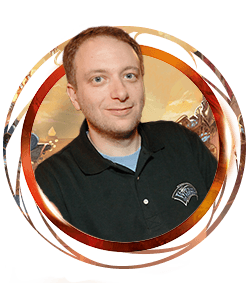
Mark Gottlieb (lead)
The first time I ever met Mark Gottlieb was through a letter. He wrote to me to see if I could use an editor for my Magic puzzles ("Magic: The Puzzling," which appeared in The Duelist and Duelist Companion, a magazine and newsletter, respectively, about Magic we made back in the day). At the time, Mark was an editor for GAMES Magazine. He was both a puzzle and Magic enthusiast and he wanted to see if he could help me out. He didn't want to charge anything; he just saw it as a way to combine his two passions. Okay, and maybe he was trying to build a relationship that could lead toward him maybe one day working for Wizards. I turned him down. (Not because I didn't want his help—my puzzles most often used cards that weren't public at the time of me making them, and he didn't have the permission to see them.)
Mark would eventually get a job as a Magic editor. That would lead to him getting involved with the rules and ultimately becoming the Rules Manager, a position he held for many years. After he stepped away from that, Mark became a developer focusing on casual-level play. That job segued into him becoming a designer, where he worked on many design (and development) teams, eventually leading Mirrodin Besieged, Commander (2013 Edition), Dragons of Tarkir, Shadows over Innistrad, and Aether Revolt and co-leading Gatecrash with me. Mark has since become a manager overseeing the design team.
I think all designers are influenced by the other things in their life. Mark's designs are very much a product of his love of puzzles. The design of a good puzzle requires the component pieces intricately working together, often in a way that has to be discovered as the puzzle is explored. Mark's Magic designs function in much the same way. I remember at one point in Aether Revolt's design, Mark made a graph where he showed how the various different components of the design intersected with one another. It's the closest thing I've ever seen to an encapsulation of how Mark looks at a design he's working on.
With all his managing, Mark doesn't get to design as much stuff as he once did, but I'm always happy when I see he's able to be on a design team.
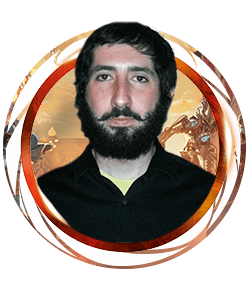
Ari Levitch
I met Ari on his first day at the job. He had just joined the creative team as a contractor with a story background. I was wearing some superhero shirt (as I am apt to do) and he and I struck up a conversation about comics. We've had so many comic conversations over the years that I have no memory which one was the first. What I do remember is being impressed with his take on whatever we were discussing. It was a different vantage point than mine, but that's something I like to see in coworkers—that they come with their own fresh perspective.
Ari and I worked together for the first time on the Battle for Zendikar design team. (His first design team was actually Magic Origins, but I usually didn't work on core set design teams.) Ari and I worked together on Oath of the Gatewatch and Aether Revolt, as well as the fall set of 2018 (codenamed "Spaghetti").
The best design teams are the ones where each person adds their own distinctive contributions, and Ari always approaches designs trying to figure out how we can capture the essence of what the world and story want to be. Whenever we examine a new mechanic or a new card, I can always see the wheels turning in Ari's head trying to figure out how we'll concept it and how it will reinforce the creative elements of the set. Aether Revolt had an extra challenge in that the story took a strong turn and thus had a different feel than Kaladesh. As always, Ari was on top of it, and as I'll talk about this week and next, we navigated our way through a challenging design.
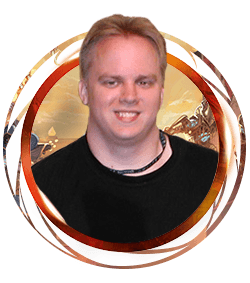
Ken Nagle
My first interaction with Ken was also through a letter. Ken wrote a lengthy, somewhat aggressively toned letter explaining how we were managing white incorrectly. (Interestingly, Ken actually is the biggest fan of green.) Over the years, I got a few more letters from him. His style was so distinct that I remembered him. Then during the first Great Designer Search, when I was narrowing the field down to around 100 people to take the final design test, I noticed that Ken had made the cut.
The way the test worked was that I sent it out and then gave everyone a deadline about three days later. People were allowed to turn their text in at any time during the 24 hours of the deadline. Ken turned his entry in at exactly midnight, the absolute earliest time it could be turned in. The second person to turn their test in (remember of 100-plus people) was over 12 hours later. That meant when I came in first thing and checked my email to see if anyone had turned their test in, there was only one test there—Ken's. I remember thinking it was a very risky strategy, but it definitely got me to notice Ken. I remembering looking at his test wanting to be able to say "Man this is rough, you should have spent more time on it rather than making some crazy bold statement." Instead my reaction was "This is good."
Ken went on to finish second in the Great Designer Search, which got him a six-month internship, which led him to getting a full-time job as a designer. Ken has been on more design teams than anyone in the building other than me (and maybe Gottlieb), and led Worldwake, New Phyrexia, Commander (2011 Edition), Return to Ravnica, Born of the Gods, Fate Reforged, and Eldritch Moon and co-led the 2017 fall set (codenamed "Ham") with me. I've written so many bios and said so many nice things about Ken as both a person and a designer. It's all still true and as always, it was great having Ken on the design team.
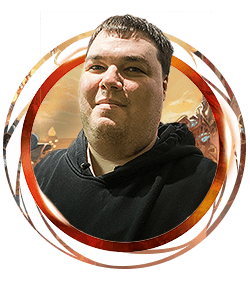
Adam Prosak
The first time I met Adam was at a Pro Tour. Adam says the very first time we met was when he competed in one of the trivia game shows (called "Question Mark") I used to run at the Pro Tour. Adam says his team always did well but never won. I definitely knew of Adam long before I knew Adam. My first memory of meeting Adam was on his first day. Normally what I do when we get a new hire in the pit is introduce myself and ask for them to write down first impressions as they get up to speed on the new sets. First impressions are hard to come by, so I always savor each one.
Adam's first design team, which he led, was Tempest Remastered. But of Standard-legal sets, his first design team was Oath of the Gatewatch. Adam was also on Kaladesh and Aether Revolt. On all of these teams, his role has been the development representative. It's a very hard role because they're always the person that has to on the fly try to balance something that quite often has never been done before. ("Here's Vehicles, a brand new card subtype. So how would you choose the right crew number?")
Adam is very analytical and is good about trying to walk everyone on the team through his thought process. Kaladesh block mechanics have definitely kept Adam on his toes.

Gavin Verhey
The first time I met Gavin was spellslinging at a Prerelease when he was very young. (His best guess is that it was Mirrodin.) Interestingly, the first time Gavin remembers me having a meaningful conversation with him was at the Prerelease of one of sets returning to the plane, New Phyrexia. I was curious whether or not he would expect infect to return if the Phyrexians did.
The first interaction I had with Gavin inside Wizards was for an interview for a job he didn't get, working on our Duel Masters game. After he was hired later, my first interaction with him (other than a quick hello and introduction on his first day to gather first impressions) was the day I asked him to pose for a "Tales from the Pit" comic.
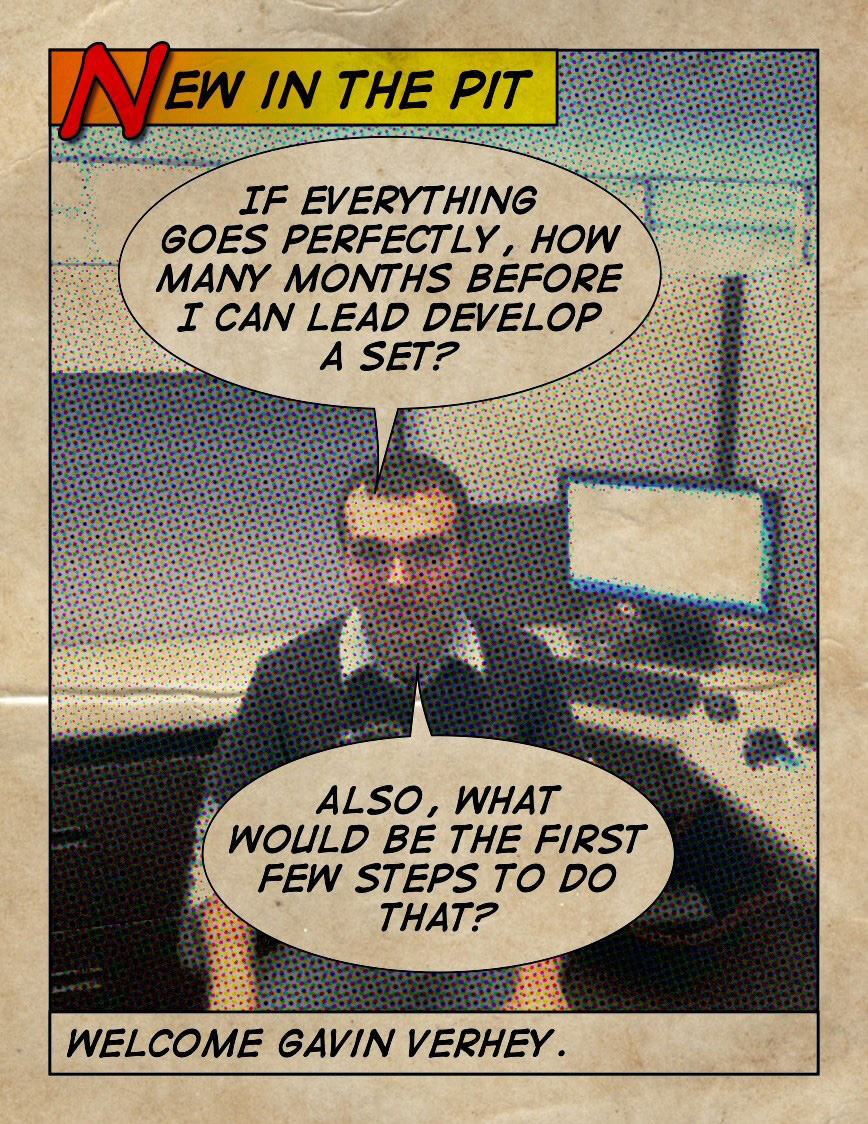
Gavin is the one designer on the team who backed into design. He was originally hired as an intern for development, but Gavin tended to bounce around R&D and ended up doing a wide variety of different jobs. He came to design originally to do what we call "experience design" (designing events), but soon became a regular on design teams. Gavin was on the Fate Reforged and Shadows over Innistrad design teams as well as Aether Revolt. His first design lead was with Archenemy: Nicol Bolas, coming out next year.
Gavin is very much a jack of all trades and brings a whole host of skills to any design team he's on. It has been very interesting to watch him grow as a designer and I think we're going to see great things from him as he continues leading his own designs.
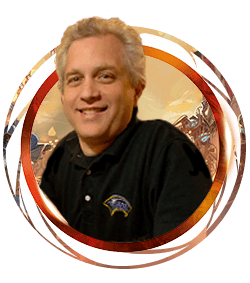
Mark Rosewater
Two years ago, I talked about how we were changing the way we were going to make Magic. Instead of one block with three sets and a core set, we were going to have two set blocks each with a large and small set. We work a little over two years ahead, so that means we've finally got to the first set where we start to see some impacts of the change. In fact, one of the ongoing themes in my column is going to be me explaining how we've adapted to the new system.
The very first impact technically happened in Kaladesh. To be able to help set vision for the large sets, I started co-leading sets. For Kaladesh, as an example, I co-led the design with Shawn Main. We were both on the set for the full twelve months, but I started the design and then handed the reins to Shawn six months in. This was so I could start work on Amonkhet, which I co-designed with Ethan Fleischer. As a side effect of working on two large sets at once (in the past I only worked on one large set at a time), I had less time for the small sets. To make up the time, my solution was to attend the small sets part-time. Design meets twice a week, so I attended one meeting each week. What this meant was I was there but not at the capacity I've normally been on small sets. I bring this up because this fact will matter as the story of adapting to the new system evolves.
How Revolt-ing
When you start with any small set, the first thing you have to figure out is how much of the large set you will be keeping and how many new things you will be adding. Let's begin by examining the first part. What from Kaladesh was supposed to be in Aether Revolt?
Let's look at the mechanics:
Energy—Energy is not the kind of mechanic you introduce in the first set and then drop in the second. It is core to the set's creative side and its play identity. It was also the highest-rated new mechanic in the Kaladesh market research. Ironically, I think leaving it out would lead to a player revolt. (Hmm, that would have been on-theme...) Luckily, it has a very deep design space, so there were plenty of new nooks and crannies to explore.
Vehicles—Vehicles falls pretty much in the same camp. They're core to the world and popular with the players. While Vehicles don't quite have the design space depth of energy, there was plenty of space left to explore.
Fabricate—Of the three new mechanics in Kaladesh, fabricate was popular but clearly third in line. Probably its biggest issue was that its design space was a lot tighter than we first thought. The more development played with the numbers, the more they realized that there just weren't that many sweet spots to hit with power-toughness/mana combinations. By removing fabricate from Aether Revolt, we opened up the opportunity to have not one but two new mechanics.
Now let's look at themes:
Artifacts Matter—Kaladesh is clearly an "artifact set." While none of the mechanics push toward playing artifacts specifically (other than Vehicles being an artifact subtype), there are a lot of individual cards that have an "artifacts matter" theme. For Aether Revolt, the design and development teams not only wanted to keep that theme but to dedicate one of the new mechanics to it. More on this below.
+1/+1 counters—+1/+1 counters did a good job of conveying the feel of creatures being enhanced by technology. With the loss of fabricate, Aether Revolt would have to turn down the level of this theme, but there was a conscious effort to make sure that there were new cards that could support it.
Artifact creature tokens—One of the ways that Kaladesh managed to have enough artifact creatures without having to dedicate too many slots to them was to have the majority of the token-making dedicated to making artifact creatures. Losing fabricate also brought this theme down some, but we felt we could compensate it with other cards.
Tribal Support—Pilots, Servos, and Artificers all saw a little bit of tribal support in Kaladesh. Aether Revolt wanted to provide some more for people making those decks.
So, Aether Revolt would continue energy and Vehicles and would support the "artifacts matter," +1/+1 counters, artifact creature tokens, and tribal themes. Finally, the design of Kaladesh was built around the theme of "Do you feel like an inventor?" We increased the synergy and variance of play and made more Johnny/Jenny-ish cards than normal to help create a lot of moments of cleverness as you invented through gameplay and deck building. It was important this feeling continued.
Now we get to the other question: What new things did we want to add?
World's Un-Fair
The biggest driver for new content was the story. Kaladesh begins with the optimistic sunny world of Kaladesh, where the people have gathered for a giant Inventors' Fair. The story ended on a darker note though, as the government confiscated all the inventions from the Fair. Thanks to Chandra's backstory, we knew coming in that not everyone on Kaladesh was happy with the Consulate. Aether Revolt, as the name clearly implies, is about these renegade forces making some bold moves.
What that meant for the design was that we needed to figure out a way to convey the feel of a revolt. Yes, the inventors of the world were still inventing, but now they were building something more practical, something that could be used for conflict.
This leads me to my preview card, which shows off improvise, one of the new mechanics. Technically, the set's other mechanic, revolt, was designed earlier chronologically, but I'm going to talk about improvise first as it's on my preview card. I'll get to revolt next week in Part 2.
World, I'd like you to meet Whir of Invention.
Click here to get acquainted!

So where did improvise come from? It turns out it was inspired by a mechanic that came out in a popular large fall set I led the design for many years ago on a world so popular we revisited it. Convoke from Ravnica? Um, no. While the final form of improvise is very similar to the convoke mechanic, the mechanic that actually inspired it was affinity for artifacts in original Mirrodin.
Here's how it happened. Design originally had planned to keep fabricate in the set and only introduce one new keyword, but once the file got to development and they started trying to create a new batch of fabricate creatures, it became clear there just wasn't enough space to do it well. By removing fabricate, they opened up the set to having a second mechanic, which allowed them to try and do something that they really wanted to do—make a mechanic where artifacts mattered.
The Kaladesh design team worked very hard to see if we could make a mechanic that interacted with artifacts. We designed one called "reverse engineer " that allowed you to copy an artifact for the turn—you made an artifact copy that got sacrificed at end of turn—but it ended up getting pushed out when we chose to focus on energy and Vehicles, two other similarly complicated mechanics. Vehicles was exclusively on artifacts and fabricate made artifact creature tokens, but neither of the mechanics actually cared about artifacts. The Kaladesh design team, and later the development team, came to the conclusion that individual card designs could carry the "artifacts matter" theme.
The Aether Revolt design and development teams were eager to see if they could find a mechanic that worked. But when it was originally decided to carry over all three mechanics and there was only enough room for one new mechanic, it had to be allocated to capturing the feel of revolt. (Once again, more on this story next week.)
With the removal of fabricate, a second mechanic was on the table. The development team was eager to finally find an "artifacts matter" theme. A mini design team was put together to find possible mechanics that would work. They made numerous suggestions, but the development team became partial to a reprint mechanic rather than a new one. (Kaladesh had not had a repeated mechanic, which we normally do each block.) There was some experimentation with proliferate in design (the Kaladesh team had also tried to make it work), but the mechanic that the development team took a shining to was affinity for artifacts.
Affinity for artifacts first appeared in the original Mirrodin block as an "artifacts matter" mechanic. The more artifacts you had, the cheaper spells with affinity for artifacts became. affinity for artifacts is considered one of R&D's biggest misses developmentally, and we ended up making a monster of a mechanic that broke its environment, leading to the greatest number of cards ever banned in Standard at once.
The development team was looking for a mechanic that rewarded you for having a lot of artifacts. Between the extra artifacts and all the artifact creature tokens, Kaladesh block created an environment where caring about how many artifacts you had would shine. Affinity for artifacts seemed to be a perfect fit. Yes, there would need to be some care with how to balance the cards, but Ben Hayes (Aether Revolt's lead developer) and his development team felt they were up to the task.
That's when Erik Lauer, the head developer (my parallel in development) stepped in. He understood what the team wanted, but warned them that the danger of affinity for artifacts was that it allowed you to cast numerous artifacts a turn, each getting the discount. If there was a way to limit the boost to only one spell a turn, the mechanic would be much more reasonable. What if when you used a mechanic to reduce a cost, you tapped it much like you tap a creature that attacks? Tapping is an age-old means in Magic to show that you've used something.
Ben was skeptical at first. Erik's suggestion was essentially an artifact version of the convoke mechanic from Ravnica. Erik asked them to humor him and try it. They did, and to the team's surprise it played wonderfully. It did everything they wanted while also keeping the mechanic from spiraling out of control. And thus, improvise was born.
But Wait There's More
I've run out of time and have only gotten to one of the two new mechanics. Luckily, this is just Part 1, which means I have more time next week to finish my story. As always, I'm eager to hear your feedback, both about today's column and Aether Revolt. You can email me or contact me through any of my social media accounts (Twitter, Tumblr, Google+, and Instagram).
Join me next week for Part 2 and revolt.
Until then, may you find a way to improvise your own way to victory.
"Drive to Work #392—Designing Uncommons"
In this podcast, I talk about the challenges of designing uncommon cards.
"Drive to Work #393—Top 10: Evergreen Creature Keywords"
This is another Top 10 podcast. In this episode, I pick my Top 10 favorite evergreen creature keywords.
- Episode 391 Cohesion (20.5 MB)
- Episode 390 Urza's Destiny, Part 4 (22.8 MB)
- Episode 389 Urza's Destiny, Part 3 (29.0 MB)

